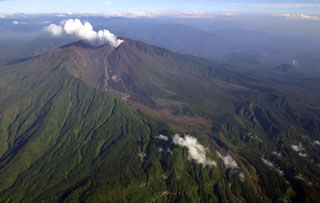Report on Reventador (Ecuador) — 19 January-25 January 2022
Smithsonian Institution / US Geological Survey
Weekly Volcanic Activity Report, 19 January-25 January 2022
Managing Editor: Sally Sennert.
Please cite this report as:
Global Volcanism Program, 2022. Report on Reventador (Ecuador) (Sennert, S, ed.). Weekly Volcanic Activity Report, 19 January-25 January 2022. Smithsonian Institution and US Geological Survey.
Reventador
Ecuador
0.077°S, 77.656°W; summit elev. 3562 m
All times are local (unless otherwise noted)
IG reported that a high level of activity continued at Reventador during 18-25 January. Gas-and-ash plumes, often observed multiple times a day with the webcam or reported by the Washington VAAC, sometimes rose higher than 1 km above the summit crater and drifted mainly NW, W, and SW. Crater incandescence was visible at night during 19-20 January. Cloudy weather sometimes prevented visual observation during 21-23 January. Lava flows on the E and NE flanks were visible during 23-25 January and continued to advance.
Geological Summary. Volcán El Reventador is the most frequently active of a chain of Ecuadorian volcanoes in the Cordillera Real, well east of the principal volcanic axis. The forested, dominantly andesitic stratovolcano has 4-km-wide avalanche scarp open to the E formed by edifice collapse. A young, unvegetated, cone rises from the amphitheater floor to a height comparable to the rim. It has been the source of numerous lava flows as well as explosive eruptions visible from Quito, about 90 km ESE. Frequent lahars in this region of heavy rainfall have left extensive deposits on the scarp slope. The largest recorded eruption took place in 2002, producing a 17-km-high eruption column, pyroclastic flows that traveled up to 8 km, and lava flows from summit and flank vents.
Source: Instituto Geofísico-Escuela Politécnica Nacional (IG-EPN)

